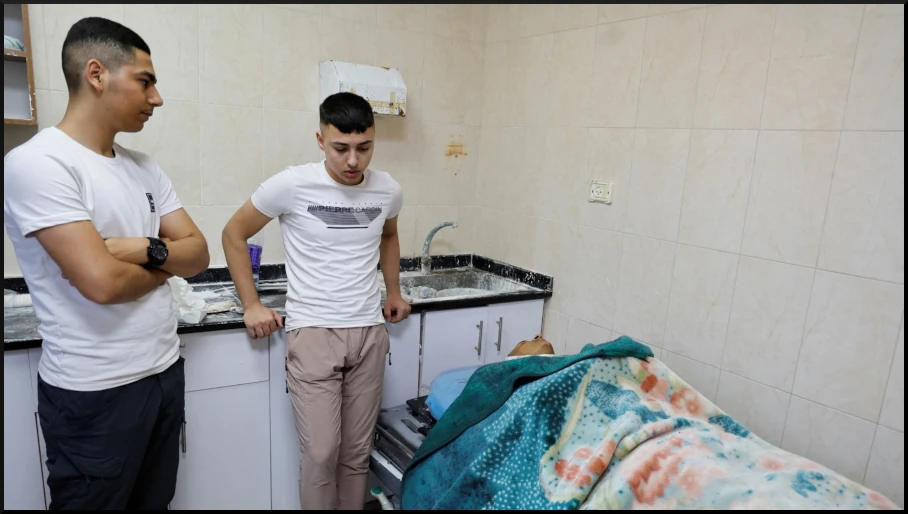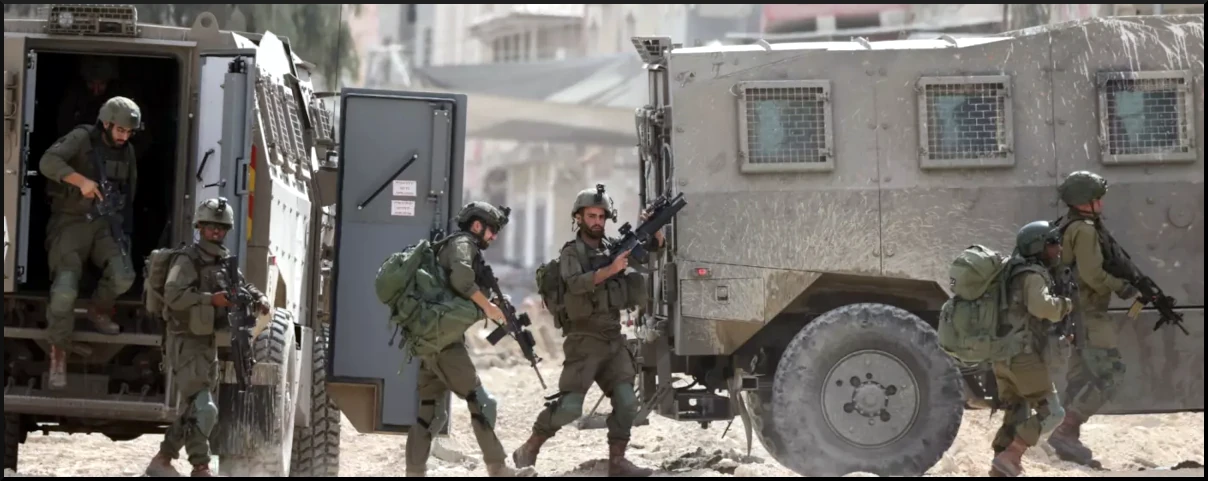By Fayha Shalash in Ramallah, occupied Palestine and Huthifa Fayyad, published on Middle East Eye, August 28, 2024
Israel launched its largest offensive on the occupied West Bank since the Second Intifada, attacking three cities – Jenin, Tulkarm and Tubas – from land and air.
Drone strikes were reported in the three cities as troops opened fire at Palestinians on the ground, killing at least nine people, including seven in Tubas and two in Jenin, according to the Palestinian health ministry.
The assault began just after midnight local time (21:00 GMT) after undercover Israeli soldiers entered the Jenin refugee camp and the Nur Shams refugee camp in Tulkarm.
In Tubas, Israeli troops arrived via military helicopters and led the assault there, particularly in the Far’a refugee camp, according to Israeli and Palestinian media.
Large numbers of Israeli forces then raided the camps and besieged hospitals, preventing paramedics from reaching them, according to eyewitnesses and the Palestinian Red Crescent Society.
An ambulance officer from the city told Middle East Eye Israeli forces raided an ambulance station in the Far’a refugee camp and briefly held paramedics outside.
Adnan Ghoneimi said Israeli soldiers forced medical teams to leave the station and lined them up against a wall as they searched the facility.
Paramedics in the city had been blocked from reaching the camp since the raid began at midnight, he added.
A siege has been imposed on all the three cities – Jenin, Tulkarm and Tubas – in the northern West Bank, cutting them off from the rest of the Palestinian territory.
Shatha Sabagh, a Jenin camp resident, described the raid as the largest she has seen in years.
“The number of military vehicles storming Jenin is very large,” she told MEE.
“The three main hospitals are besieged and all the streets leading to the city are closed with dirt barriers. We have not witnessed an incursion this extensive for a long time, and it seems that it will continue for several days.”
Israeli soldiers took position in several buildings in the city and deployed snipers on rooftops, shooting at anyone that moves in front of them, she added.
Meanwhile, the city has been paralyzed, with workers and students forced to remain indoors. Residents have also not been able to bury those killed in the raid so far amid the tight siege imposed by the military, according to Sabagh.
Khaled Sobh from Far’a camp described a similar scene there.
“The situation in the camp is catastrophic and the incursion is the largest it has ever seen,” he told MEE.
“Ambulances are prohibited from moving. The wounded were smuggled to hospitals because of all these closures.”
According to Sobh, Israeli forces were “brutally” raiding home and using residents as human shields. He said at least one family was used as a cover for soldiers when they moved to the rooftop of their home to set up there.

Ghoneimi confirmed that an Israeli drone bombed the camp at dawn, killing four people.
Ambulance crews managed to reach the area hours later and were shocked by the strike’s impact.
In the Nur Shams camp near Tulkarm, eyewitness Bayan Mansour said soldiers began terrorising residents and besieging the two main hospitals as soon as they arrived after midnight.
“The raid and the movement of vehicles and soldiers prove that they are preparing themselves to stay for a long period of time,” Mansour told MEE.
“The clashes have not subsided and we hear the sounds of explosive devices exploding from time to time,” she added.
A large number of military bulldozers were reported in all three cities, razing roads and destroying critical electricity and water infrastructure.
Largest raid since Second Intifada
The Israeli military said it was carrying out a large “counter-terror” operation in Jenin and Tulkarm without elaborating further.
Military sources told the Times of Israel that the attack was expected to last several days. Israel’s Channel 12 said four battalions are involved in the offensive, including ground troops and the air force.
Meanwhile, the public broadcaster Kan News reported that the assault is the largest conducted by the Israeli military since the 2002 “Defensive Shield” attack at the height of the Second Intifada.
Shortly after the raid began, Israel’s Foreign Minister Israel Katz called for the “temporary evacuation” of Palestinians from parts of the occupied West Bank.
Katz said the military was working “intensively” in refugee camps in Jenin and Tulkarm to “thwart Islamic-Iranian terrorist infrastructures” he claims to exist there.
“We must deal with the threat just as we deal with the terrorist infrastructure in Gaza, including the temporary evacuation of Palestinian residents,” Katz added.
“This is a war for everything and we must win it.”
Meanwhile, Palestinian armed groups in the targeted cities, including the local chapters of Hamas, Islamic Jihad and Fatah, said their members were confronting the Israeli military, including detonating explosive devices against troops.
News outlet Israel Hayom described fighting in the camps between soldiers and Palestinians as “heavy and difficult“.
The Tulkarm branch of the Islamic Jihad took responsibility for an attack on an Israeli military bulldozer using a roadside bomb.
Footage by local media showed Israeli forces evacuating a damaged bulldozer from the city.
The Islamic Jihad also claimed to have hit snipers in Tulkarm during an exchange of fire and said its fighters downed an Israeli drone.
There were no immediate reports of Israeli casualties.
Hospitals besieged
The Jenin Governmental Hospital, also known as the Khalil Suleiman Hospital, remains under Israeli siege almost 12 hours after the West Bank city was raided, the hospital’s director told MEE.
Dr Wissam Abu Bakr said Israeli military vehicles surround the hospital, preventing people from entering and leaving freely.
“Ambulances that transported several casualties from the city were subjected to careful inspection as they attempted to enter the hospital, while soldiers searched the identity cards of some of those trapped in the hospital before allowing them to leave it after several hours,” Abu Bakr said.
Sniper units are also deployed in buildings adjacent to and overlooking the hospital, he added, restricting the movement of residents.
In Far’a camp, Ghoneimi said due to the closure of roads leading to the camp, paramedics had been forced to take a bumpy road to transport the dead and wounded.
Some residents were forced to cut trees near their homes to allow ambulances to drive through the narrow alleyways.
Whenever medical teams tried to reach the entrances to the camp, they were threatened by soldiers they would shoot them, Ghoneimi said.
“If we receive any call regarding emergency cases inside the camp, the paramedics try to deal with them on the field, and if they require transportation to the hospital, the ambulance tries to reach it via rugged dirt roads that take longer to pass.”
Ghoneimi told MEE the bombardment of the camp was the “most violent aerial bombardment” he had experienced.
“One of the martyrs was without a skull, shoulders or brain as if he had melted during the bombing,” he said.
*Featured Image: Israeli soldiers operate during a raid in the Nur Shams camp for Palestinian refugees near the city of Tulkarm in the occupied West Bank on 28 August 2024 (Jaafar Ashtiyeh/AFP)
